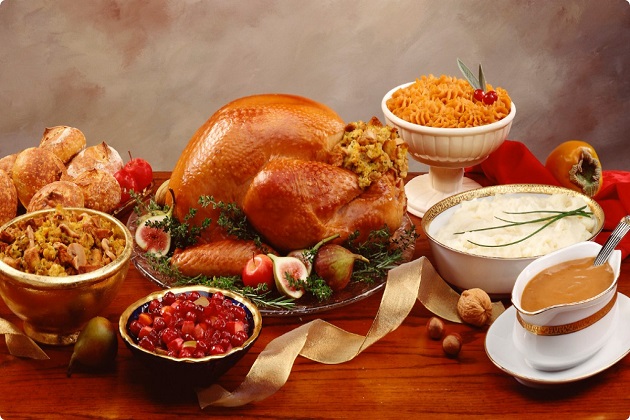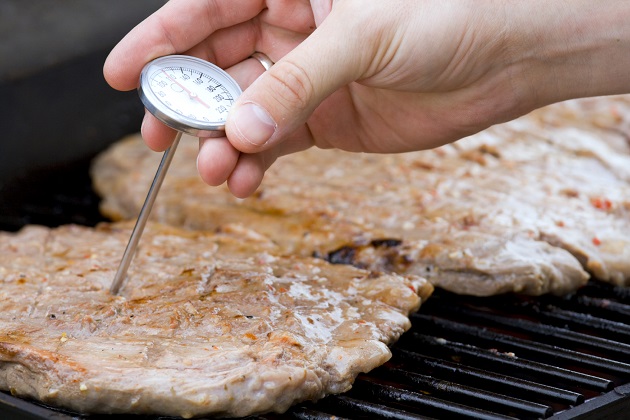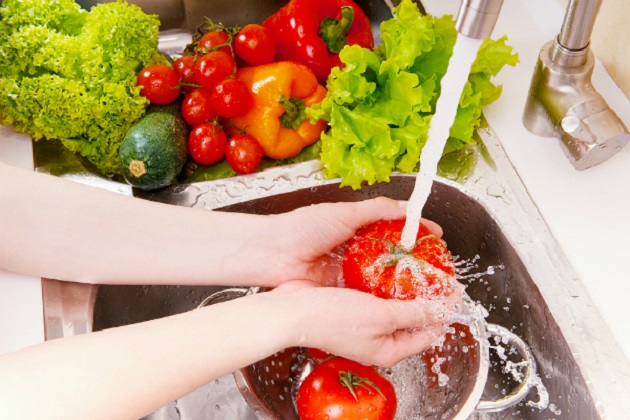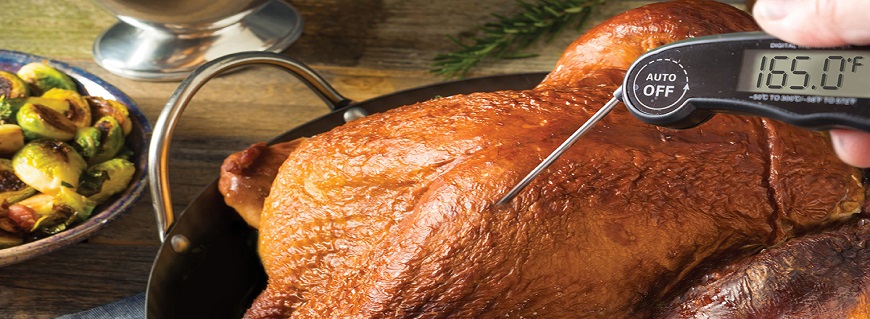
Whether you're a seasoned chef or preparing your first holiday meal, it is important to know the safest ways to thaw, prepare, stuff, cook, cool and reheat your holiday turkey.
Foodborne illness is never pleasant; by safely preparing your food, you can reduce the risk of making you and your guests ill. Here are simple tips that all cooks in the kitchen can follow this holiday season to cook a delicious and safely prepared turkey.
Turkey Basics: Safely Thaw, Prepare, Stuff, Cook, Cool and Reheat.
When preparing a turkey, it's important to know the main safety issues involved with thawing, preparing, stuffing, cooking, cooling and reheating.
Safe Thawing: Never defrost a turkey on the counter.
- Turkeys must be kept at a safe temperature - below 45 degrees Fahrenheit - when thawing.
- There are three safe ways to thaw food:
- in the refrigerator, for up to a week, depending upon the weight. This is the safest and most
practical way to defrost a turkey.
- under cold, running tap water. Never stagnant or standing water!
- in a microwave
- See instructions for each method.
Safe Preparation
- After working with raw poultry, always wash your hands, utensils and work surfaces thoroughly with soap before touching and preparing other foods. Frequent handwashing by the chef is the key to safe food handling.
- To avoid cross contamination, use a separate cutting board for all raw meat and poultry preparation, and keep raw turkey away from vegetables and side dishes that won't be cooked.
- Always prepare and serve food on clean plates - not those previously holding raw meat and poultry. This prevents bacteria from raw poultry from cross contaminating other food.
Safe Stuffing
- For optimal safety and uniform doneness, cook the stuffing outside the turkey in a casserole dish.
- If you do place stuffing inside the turkey, do so just before cooking - NEVER OVERNIGHT! Be sure to use a 0 to 220 degree food thermometer to confirm that the center of the stuffing reaches a safe minimum internal temperature of 165 degrees Fahrenheit in order to kill any potential bacteria.
Safe Cooking
- Set the oven temperature no lower than 325° F. Pre-heating is not necessary.
- Be sure turkey is completely thawed. Cooking times are based on fresh or completely thawed birds at a refrigerator temperature.
- Place turkey breast-side up on a flat wire rack in a shallow roasting pan, 2 to 2 ½ inches deep.
- For safety and uniform doneness, it is recommended to cook stuffing outside the bird. If stuffed, place dressing loosely into cavity just before turkey goes into the oven.
- The internal temperature should be checked with a meat thermometer and must reach a minimum of 165° F. Check the temperature in the innermost part of the thigh and wing, and the thickest part of the breast before removing it from the oven. The center of the stuffing should reach 165° F for at least 15 seconds.
- Juices should run clear.
- Time your meal to go from the oven to the table. Serve it hot!
- Arrange and serve food on several small platters rather than on one large platter. Keep the rest of the food hot in the oven (set at 200° F – 250° F) or cold in the refrigerator until serving time. This way food will be held at a safe temperature for a longer period of time. REPLACE empty platters rather than adding fresh food to a dish that already had food in it. Many people’s hands may have been taking food from the dish, which has also been sitting out at room temperature.
- Divide cooked foods into small shallow containers to store in the refrigerator or freezer until serving. This encourages rapid, even cooling. Do not stack the containers until refrigeration temperatures are reached. Reheat hot foods to 165° F for at least 15 seconds, rolling boil for gravy, sauces, and soups.
For more information on safe internal temperatures, visit FoodSafety.gov's Safe Minimum Cooking Temperatures.
Safely Cool Leftovers
- Leftover turkey, stuffing, etc., needs to be refrigerated within two hours from the time you remove the turkey from the oven.
- Soups and stocks should be cooled in the refrigerator, uncovered in shallow pans. They can be transferred to large, covered vessels after reaching refrigerator temperature.
- Avoid filling containers with food deeper than four inches and then stacking multiple containers on top of each other until the food has cooled to under 45 degrees Fahrenheit.
Safely Reheat Leftovers:
- Leftovers, including turkey meat, stuffing and stock should be reheated to at least 165 degrees Fahrenheit before serving.
- Always use a 0 to 220 degree probe thermometer to check the temperature of reheated food.
Resources:
- USDA Meat and Poultry Hotline: (888) MPHotline (888-674-6854)
- Food Safety (CDC)
- Is Pink Turkey Meat Safe? (CDC)
- Alternative Ways to Cook Turkey - How to grill, smoke, microwave, and deep fat fry turkeys.
- Turkey Roasting Chart
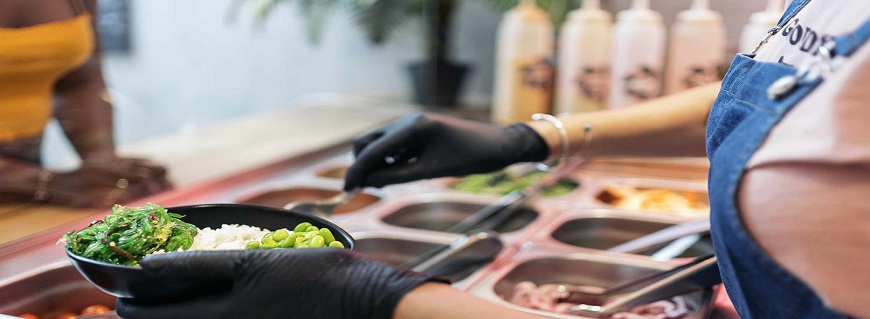
Residents and visitors have thousands of places to choose from when they want to eat out in Westchester.
Restaurants, cafes and other eateries that prepare food on site receive regular inspections by the Health Department to help ensure that your meal is prepared and cooked safely. So whether you plan to dine out at a restaurant, grab a quick bite from a hot dog truck or a fast food chain, or have your child buy lunch at your school cafeteria, we’ve got you covered.
Health inspectors, who are known as Sanitarians, ensure that safeguards are in place to protect food from contamination, both by the people who handle the food as well as from other sources. During a visit, health inspectors look to see that employees regularly wash their hands in a sink that has soap, hot water and paper towels; that utensils and surfaces that come in contact with raw meat are not used to prepare ready-to-eat foods; that foods are kept at the appropriate temperature and that rodents and other pests are not present.
View Inspection Reports Online
Health inspectors prepare a written report whenever they inspect a food service establishment. These inspection reports can be viewed online at New York State Department of Health/Health Data. Within the reports, there are sections available for the inspector to list critical and non-critical violations.
It’s helpful to know:
- A Critical Violation is a violation that relates directly to factors which may lead to food borne illness.
- A Non-Critical Violation is a violation that relates to maintenance and cleanliness of food Service operations.
Food service establishments that are considered high-risk are generally inspected twice a year. High-risk establishments are full service, dine-in restaurants that prepare and cook large quantities of raw food on site. Establishments that are considered medium-risk and low-risk are inspected once annually. Medium-risk establishments are those that serve mostly commercially prepared food and are typically fast food chain restaurants like McDonald’s and Burger King. Low-risk establishments are those that have limited or no food preparation on site, like ice cream shops and bars. Critical violations are corrected at the time of inspection and non-critical violations are given a re-inspection date and must be corrected by that time.  Report a Food Borne Complaint or Illness
Report a Food Borne Complaint or Illness
All complaints concerning improper food handling, poor sanitary practices or food borne illness related to food service establishments in Westchester County will be investigated by the Health Department. If you would like to file a complaint about a food service establishment, call (914) 813-5000.
Supermarkets and Convenience Stores
Some establishments, such as supermarkets and convenience stores, are not regulated by the Health Department. For more information or to make a complaint about these types of establishments, contact the New York State Department of Agriculture and Markets or call (800) 554-4501.
Calorie Posting and Allergy Notice
In Westchester County, all chain restaurants are required to count calories for you and post them on their menus and menu boards. In addition, all restaurant menus and menu boards must also include an allergy notice to remind you to speak to the owner, manager, chef or server if you have a food allergy. These calorie counts and allergy notification postings allow you to make the best informed decisions about what you choose to eat when you dine out.
Additional Resources
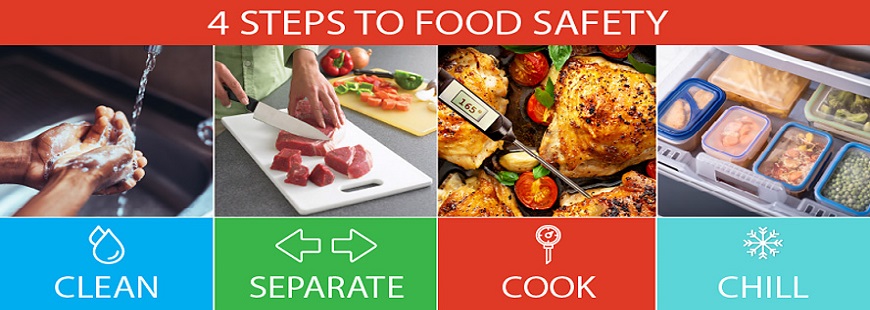
Single-Use Foodware Law
Westchester County is reminding residents and business owners of its "Upon Request" single-use foodware law, which took effect on September 2, 2023. This legislation aims to reduce the consumption of single-use plastics by promoting a more mindful approach to their usage within food service establishments by limiting the use of single-use foodware products to only when specifically requested by the customer.
Food service establishments are required to prominently display this clearly legible sign (in Spanish and Chinese) informing customers that plastic utensils, condiments, and straws are available only upon request.
For more information, view the county's press release, and fact sheet (in Spanish and Chinese) on the law.
Food Allergy Restaurant Safety Law effective November 9, 2022
The Westchester County Board of Legislators has enacted a “Food Allergy Restaurant Safety” Law that became effective November 9, 2022.
The new law (Chapter 541 Food Allergy Restaurant Safety) requires you to post signs in English and Spanish, (both in the front of your establishment so the sign is visible to customers and in the back of your establishment, so it is visible to food handlers) which provide food allergen information to patrons and staff. In addition, you are required to designate staff who will be trained in an approved Allergen Training Program. If you provide seating for your customers, you must always have at least one trained person in the kitchen and one trained person in the dining room during hours of operation. If you are take out only, you must have a least one trained person in the kitchen during hours of operation. The number of trained staff must also be entered in the space proved on the posted signs. The Westchester County Health Department has designated the following courses as acceptable, ServSafe Food Allergen class and StateFoodSafety AllerTrain Course, and FARECheck. If you wish to take another course, please contact us prior to registering to verify it is approved.
The required signs are available for printing. If you wish to pick up pre-printed signs in both English and Spanish, you can come to the office at 25 Moore Avenue, 2nd Floor, Mount Kisco, NY 10549 any Monday through Friday between the hours of 9:00 am and 4:00 pm. If you have questions regarding this code, please feel free to contact your inspector directly, or you can call the office at (914) 864-7330.
- Chapter 541: Food Allergy Restaurant Safety Law (pdf)
- Food Allergies Can Be Serious Poster, (11 x 17, pdf)
- Food Allergies Can Be Serious Poster, Español (11 x 17, pdf)
Restaurant managers have a lot on their plates, but food safety can be second to none when running a food service establishment. That’s why the Westchester County Department of Health is helping restaurateurs keep their customers safe by providing them with opportunities to learn how to protect the food they serve from intentional contamination.
Thanks to funding from a grant awarded by the Food and Drug Administration, the Health Department offered a free Food Defense Workshop that was attended by nearly 30 food service professionals. Strategies to assure the safety of food supplies, deliveries and storage, as well as how to identify and report suspected problems were all part of the keynote presentation.
Public health sanitarians aim to promote healthy people and communities through education and regulation of food service establishments.
Did you know that there are about 4,000 establishments serving food in Westchester County, including restaurants, mobile food carts and deli's? The Westchester County Health Department inspects these establishments and those inspections can be viewed and downloaded.
State and county sanitary codes are enforced by public health sanitarians to ensure that the public is served food that is healthy and safely prepared. Restaurants and mobile food vendors receive unannounced inspections routinely throughout the year. Random samples of milk, frozen desserts and utensils are taken to find and correct possible food contamination.
Working with public health nurses and physicians, sanitarians promptly investigate incidents of suspected foodborne disease. Public health sanitarians also respond to fires involving food service establishments. As a result of fire damage, sanitarians may order food products to be condemned or destroyed.
All food service establishments must be aware of the Food Allergy Notification Law. Restaurants can download the pre-set Food Allergy Labels, print or copy onto label sheets and apply to printed menus.
Restaurateurs who want to perform major renovation or construction of food service establishments must have their proposed plans approved first to assure that appropriate equipment and procedures are in place.
Food service owners and operators attend a Food Handler's Training course designed and developed by this department. Since the course began in 1985, thousands of food service operators have attended intensive classes, presented in cooperation with Westchester Community College.
The Health Department is active in assuring that mass gatherings and public functions maintain safe and healthful conditions.
Important Phone Numbers
- Westchester County Health Department: Food borne illness complaints, public health complaints and 24 hour emergency phone line (914) 813-5000
- Food and Drug Administration (FDA) Complaints: (425) 483-4949
- National Meat and Poultry Hotline: (800) 535-4555
- New York State Restaurant Association: (800) 452-5212
- New York State Department of Health: (800) 458-1158
COVID-19 Guidance Signs for Food Service Operators & Staff
- December 15, 2021: Proof of Vaccination Poster for Businesses (NYSDOH)
- December 15, 2021: Mask Mandate Poster for Businesses (NYSDOH)
- COVID-19 Guidelines: Food Service Operators and Staff (8 1/2 x 14)
Food Service Establishment Regulations and Laws
- Sanitary Code of Westchester County
- Food Allergy Notification Law
- Food allergy labels for use on printed menus in restaurants
- Article XXI, additional food service fees effective August 1, 2019
- Calorie Labeling Law for chain food service establishments
Food Safety Handlers Course
- View/print the Summer 2023 Food Handler Course Schedule/Registration Form offered through Westchester Community College. The courses will be instructed remotely with final exam on WCC Valhalla campus.
- New York Food Allergen Awareness Class is recognized throughout the United States and has been designed to meet employment, general continuing professional development (CPD), and continuing professional education (CPE) requirements
Forms
All permit application fees are non-refundable.
- Original Permit to Operate a Food Service Establishment
- Original Permit to Operate a Mobile Food Service Unit
- Mobile Food Unit Inspection Schedule 2025 (by appointment only)
- Commissary List (2025)
- Temporary Food Service Application Form
- Notice of Intent to Construct, Enlarge or Convert a Facility
- Notice to Preparers of Plans for Construction and Major Renovations of a Food Service Establishment (updated 6/2022)
- Application for a Permit for a Public Function
- Planning a Fundraiser? Food Safety at Community Events brochure
Recycling information
- Curbside Recycling Guide
- How to dispose of and recycle barbeque and propane tanks
- Recycling mercury
Health Advisories
- When the power goes out (NYSDOH)
- Food Safety Alerts from the FDA
- Health Advisory for New York Sportfish and Game (NYSDOH)
- Why Foodborne Illness Peaks in Summer (USDA)
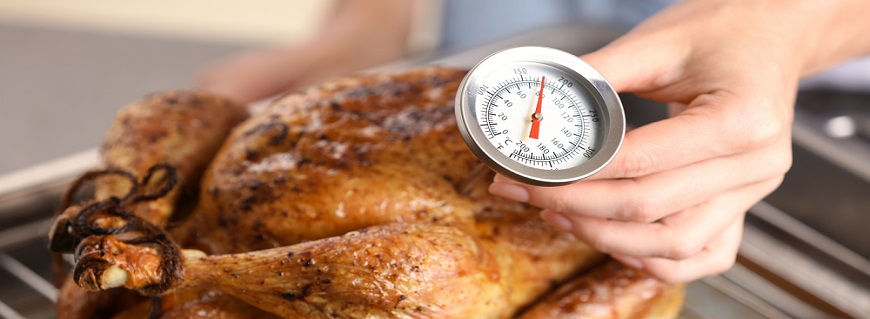
As you fire up the grill and get ready for some outdoor fun, the Health Department has tips to help you BBQ and picnic safely to prevent food borne illness from spoiling your day.
Perishable foods should never be thawed on the counter or in hot water and must not be left at room temperature for more than two hours. There are safe ways to thaw food:in the refrigerator, in cold water, and in the microwave.
- Harmful bacteria usually grow in the "danger zone" between 40° and 140° F, so keep meat and poultry in the refrigerator until you are ready to cook it on the grill. Marinate it in the refrigerator too. Throw out marinades and sauces that have touched raw meat juices, which can spread germs to cooked foods. Use clean utensils and a clean plate to remove cooked meat from the grill.
- When transporting food to another location, use an insulated cooler with ice to keep it at 40°F or below. Everything should stay chilled until immediately before it will be cooked or consumed. Keep the insulated cooler out of the direct sun and avoid opening the lid too often. It helps to keep beverages in a separate cooler.
- As always, cleanliness is essential to prevent food-borne illness. Wash hands, surfaces and utensils frequently with soap and water.
- Never use the same plate, cutting board or utensils for cooked food that you used for raw meats and poultry. Bacteria in the juices of raw meat and poultry can contaminate safely cooked food.
- Meat and poultry cooked on a grill browns very quickly but may not be cooked inside. Always use a food thermometer to be sure the food has reached a safe internal temperature hot enough to kill harmful germs.
- 145°F – whole cuts of beef, pork, lamb, and veal
- 145°F – fish
- 160°F – hamburgers and other ground beef
- 165°F – all poultry and pre-cooked meats
- After cooking, keep meat and poultry at 140°F or warmer until eaten. If fully cooked meats need to be reheated, grill them to 165°F.
- Refrigerate any hot or cold leftovers promptly in shallow containers. Discard any food that is left out for more than two hours after cooking, or one hour if outside air temperature is above 90°F.
Resources:
- USDA Meat and Poultry Hotline: (888) MPHotline (888-674-6854)
-
Barbeque and Food Safety (CDC)
Watch out for these foodborne illnesses:
Listeria infection is a foodborne bacterial illness that can be very serious for pregnant women, people older than 65 and people with weakened immune systems. It's most commonly caused by eating improperly processed deli meats and unpasteurized milk products. Healthy people rarely become ill from listeria infection, but the disease can be fatal to unborn babies, newborns and people with weakened immune systems. Prompt antibiotic treatment can help curb the effects of listeria infection.
Campylobacteriosis, an infectious bacteria, is the most common bacterial cause of gastroenteritis worldwide. Symptoms generally start between 2-4 days after exposure and include diarrhea, cramping, stomach pain, vomiting and fever. Campylobacter is often spread through undercooked poultry, but can also be found in other contaminated food and water.
E. coli 0157, a virulent bacteria, primarily affects children, causes severe gastrointestinal symptoms, and can result in kidney failure. It is spread primarily through undercooked hamburgers, but cases have resulted from unpasteurized apple cider and other foods.
Cyclospora, a parasitic disease prevalent in developing countries, causes severe diarrhea and significant weight loss. It was first identified in an outbreak in Westchester County in 1995. Since that time, several outbreaks of disease were traced to raspberries from Guatemala. Disease control experts from the Westchester County Department of Health worked with Centers for Disease Control and Prevention epidemiologists to help track the disease source and bring the outbreaks under control.
Often, the source of these bacterial and parasitic diseases are fruits and vegetables imported from developing countries with inadequate sanitation. They cause diseases not commonly seen in this country. Other sources are closer to home and are caused by unsanitary conditions in the meat and poultry industry and overuse of antibiotics in animal feed. Each case of foodborne illness requires intensive follow-up by public health staff in disease control and environmental health services.
Learn more about specific foodborne illnesses from the Center for Disease Control (CDC) Website:

Cleanliness is a major factor in preventing foodborne illness.
Many harmful germs can survive for several hours on kitchen surfaces. Reduce your risk of illness by keeping cutting boards, countertops, utensils, dishcloths, and towels clean. Frequently change sponges in the kitchen. They tend to collect small food particles and are difficult to clean.
Use a weak chlorine bleach solution (2 teaspoons of bleach per quart of water) as a kitchen sanitizer. You may want to keep a supply of this solution in a spray bottle near the sink.
Tips for a safe and sanitary kitchen
- Always keep your refrigerator’s internal temperature at 41 degrees or below because bacteria can start to grow rapidly above that.
- Do not depend solely upon your refrigerator’s thermostat to gage its internal temperature. Buy an independent, hanging thermometer for less than $5 and hang it inside your fridge to double-check the reading.
- Never store raw meats, poultry or seafood above ready to eat food in your refrigerator because juices from these raw products can drip and contaminate them. Always use the bottom shelf to house raw meats, poultry and seafood to avoid cross-contamination.
- Do not store medications in kitchen cabinets above food preparation surfaces or leave them on counters where they can unintentionally find their way into the food you prepare.
- Make sure cutting boards and wooden utensils are in good condition and cleaned properly after each use. Discard any cutting boards or wooden utensils that have nicks or gouges because they can harbor bacteria.
- Sanitize cutting boards after every use by running them through the dishwasher or wiping them down with a quarter teaspoon of bleach to a quart of water; then wash them with warm water and soap.
- Have two cutting boards of different colors and use one only to cut meats and the other only to chop fruits and vegetables to avoid cross-contamination with meat drippings.
- Since meat can appear to be cooked without having reached the necessary temperature to kill off E coli, salmonella and other bacteria, always use a zero to 200 degree indicating thermometer when cooking beef, poultry or pork to assure that they are cooked thoroughly.
- To avoid getting a food borne illness from undercooked meat, ground beef must reach an internal temperature of 160 degrees, poultry must be cooked to 165 degrees and pork to 160 degrees.
Resources
- Basics for handling food safely (FDA)
- Food Facts for Consumers (FDA)
- Are you storing food safely (FDA)
- Playing it safe with eggs (FDA)

